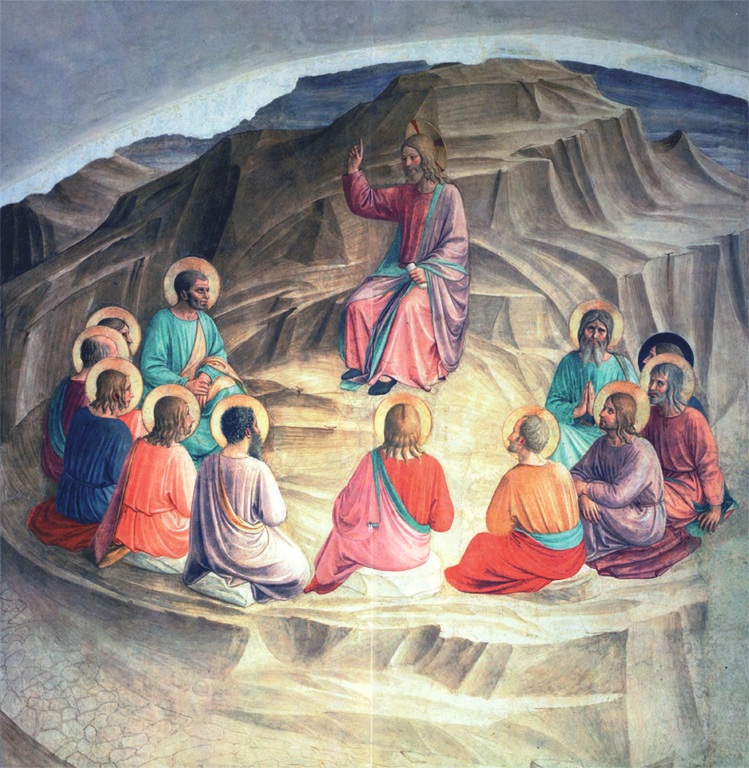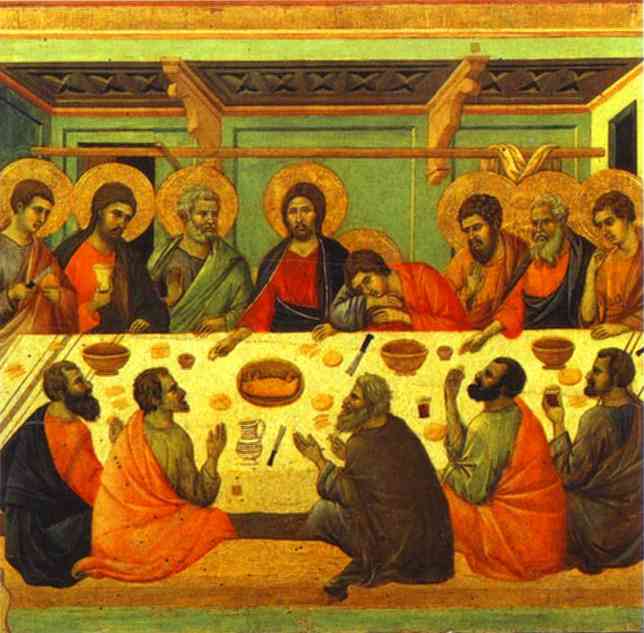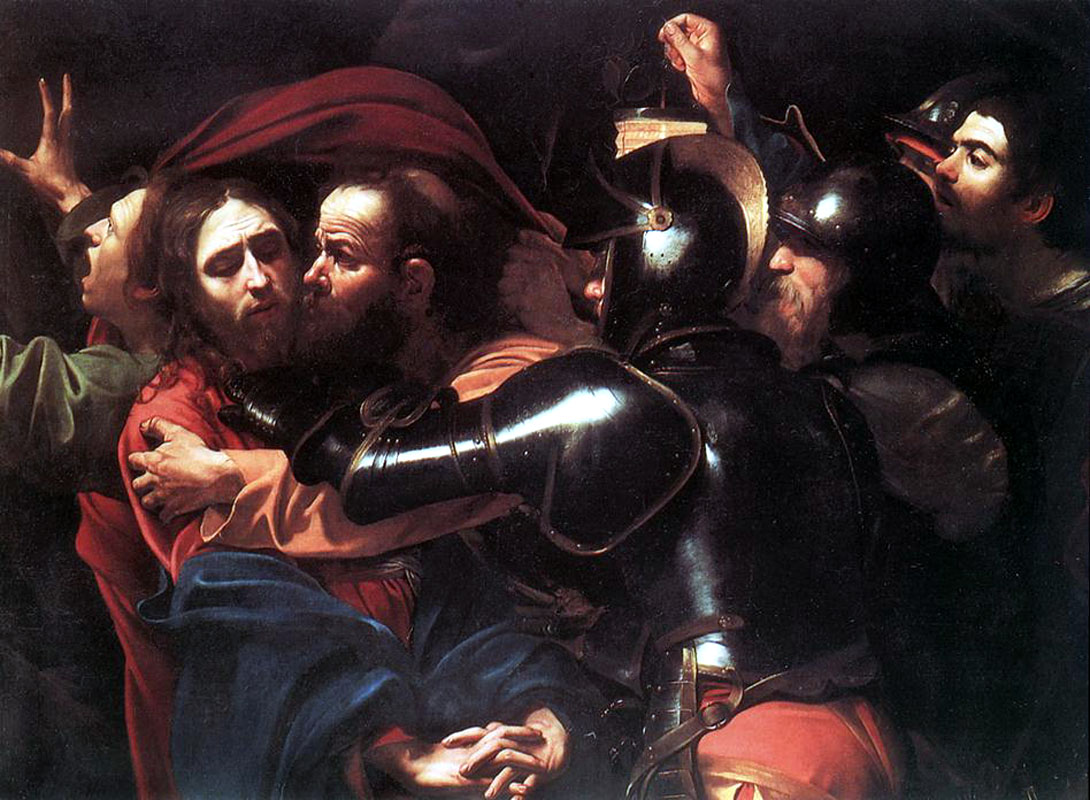The Symbolism in the Content of Fra Angelico's Frescoes
 The Sermon on the Mount Rather than talking about form, my usual interest in painting, I thought that this time I would focus on the symbolism of the content contained in an example of gothic art by focusing on a fresco of the Sermon on the Mount, once again by Fra Angelico (1395-1455). It is in cell 32 in the north wing of San Marco in Florence and was painted between 1440 and 1450. I should mention that I am indebted to a lecture given by Dr Lionel Gracey who was my colleague when I was teaching at the wonderful Maryvale Institute in Birmingham, England for much of the detailed information here. First of all there is the symbolism of the colours of Jesus’s clothes. The red under garment or tunic is red, which is a symbol of blood and a sign of his humanity; while the blue outer garment or cloak symbolizes his divinity. I was told that originally in this fresco the blue of the cloak matched precisely the heavenly blue of the sky. Fra Angelico often uses this colour symbolism for Christ and it is seen in all three liturgical traditions (although it is certainly not true to say that depiction of Christ is limited to these colours). Shown below is the Last Supper of an earlier gothic master, Duccio; a modern icon of Christ by Gregory Kroug, the 20th century Russian émigré; and The Kiss of Judas by Caravaggio from the early 17th century. All have the same colour scheme for Christ's robes. Judas is depicted in Fra Angelico’s painting as well, indicated by the black halo – an aura of darkness representing evil.
The Sermon on the Mount Rather than talking about form, my usual interest in painting, I thought that this time I would focus on the symbolism of the content contained in an example of gothic art by focusing on a fresco of the Sermon on the Mount, once again by Fra Angelico (1395-1455). It is in cell 32 in the north wing of San Marco in Florence and was painted between 1440 and 1450. I should mention that I am indebted to a lecture given by Dr Lionel Gracey who was my colleague when I was teaching at the wonderful Maryvale Institute in Birmingham, England for much of the detailed information here. First of all there is the symbolism of the colours of Jesus’s clothes. The red under garment or tunic is red, which is a symbol of blood and a sign of his humanity; while the blue outer garment or cloak symbolizes his divinity. I was told that originally in this fresco the blue of the cloak matched precisely the heavenly blue of the sky. Fra Angelico often uses this colour symbolism for Christ and it is seen in all three liturgical traditions (although it is certainly not true to say that depiction of Christ is limited to these colours). Shown below is the Last Supper of an earlier gothic master, Duccio; a modern icon of Christ by Gregory Kroug, the 20th century Russian émigré; and The Kiss of Judas by Caravaggio from the early 17th century. All have the same colour scheme for Christ's robes. Judas is depicted in Fra Angelico’s painting as well, indicated by the black halo – an aura of darkness representing evil.
Dr Gracey pointed out how unusually shod Jesus is, in a slipper of some sort rather than sandal or barefoot. He speculates that this is an allusion to the Eucharist because during Passover the Isrealites were required to be shod.
What strikes me about the composition of this fresco is the vertical dynamic in colour, light and composition that sweeps the eye up and down the painting through the geometric centre, which is somewhere around his knees. Our eyes sweep continually from earth to heaven and back, so to speak.
The colour dynamic comes in the match (when still bearing the original colours) between the blue shawl on Christ to the blue of the sky above. This causes our eyes to sweep upwards. Also, Christ’s hand points directly upwards. At this point commentaries often say that he is telling us figuratively that his kingdom is ‘not of this world’ (John 18:36). The light takes us down in the other direction. As described last week, the upper part of Christ is dark and the lower portion is light. The eye is taken from here to the brightly lit rock plateau beneath him.
A link is often made between the Sermon on the Mount and the 10 Commandments. Christ resumed these Commandments in the double precept of charity -- love of God and of the neighbour; He proclaimed them as binding in the Sermon on the Mount (Matthew 5). The mount upon which Jesus is preaching echoes Mt Sinai on which Moses was given the commandments. This parallel is emphasised by the bright illumination of the rock. Also Peter, whom Christ appears to be addressing, to his right, is ‘the rock’ upon whom He would build His Church.
Given Fra Angelico’s masterful manipulation of light (as I described last week, here) Dr Gracey suggested to me that this was the perfect painting for contemplation of the third Mystery of the Light in the Rosary, the Proclamation of the Gospel.
This is the third short article about Fra Angelico and the gothic that have been written for the New Liturgical Movement. The second was last week, already referred to and the first is archived here.



